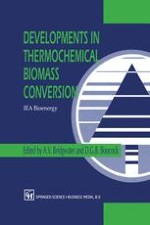
1997 | OriginalPaper | Buchkapitel
Primary and Secondary Measures for the Reduction of Nitric Oxide Emissions from Biomass Combustion
NOx reduction in biomass combustion
verfasst von : T. Nussbaumer
Erschienen in: Developments in Thermochemical Biomass Conversion
Verlag: Springer Netherlands
Enthalten in: Professional Book Archive
Aktivieren Sie unsere intelligente Suche, um passende Fachinhalte oder Patente zu finden.
Wählen Sie Textabschnitte aus um mit Künstlicher Intelligenz passenden Patente zu finden. powered by
Markieren Sie Textabschnitte, um KI-gestützt weitere passende Inhalte zu finden. powered by
Nitric oxide emissions from biomass combustion originate mainly from the fuel bound nitrogen, thermal NOx are only of minor importance. Since biomass combustion leads to higher NOx emissions than gas or light fuel oil combustion primary or secondary measures for NOx reduction are necessary for future combustion plants.To minimize NOx emissions by primary measures, the fuel nitrogen must be reduced to molecular nitrogen in zones with an excess air ratio < 1. The following techniques for the reduction of fuel NOx have been investigated: Air staging with and without separate reduction chamber, fuel staging and flue gas recirculation. It is shown that an NOx reduction of 40% to 75% can be reached by air staging with separate reduction chamber if the following conditions are met: Primary excess air ratio ≈ 0.7 –0.8, temperature in the reduction chamber ≈ 1’100° – 1’200°C, residence time ≈ 0.3 –0.5 s. Fuel staging shows a similar potential of NOx reduction. As for air staging the NOx reduction is mainly influenced by the excess air ratio in the reduction chamber. Fuel staging can only be used for large combustion plants while air staging can be used for automatic wood furnaces from app. 200 kW up to large scale combustion.If primary measures are not sufficient, secondary measures as the selective catalytic and non-catalytic reduction (SCR, SNCR) through the injection of sal ammoniac, ammonia or urea can be taken. The NOx reduction in the SNCR process is limited by the ammonia slippage. Further an accurate process control is neceassary to ensure the temperature window of app. 840°C – 920°C. To operate the combustion at low excess air ratio without exceeding the temperature limit, a partial extraction of heat before the SNCR process is necessary. By the SNCR process 60% – 80% reduction can be reached, depending on the fuel composition and the operation conditions. With SCR more than 80% (up to 95%) reduction can be achieved. However there is only little experience with the long term behaviour of catalysts in wood combustion systems.For large combustion plants combinations of low NOx and denox-techniques are considered.